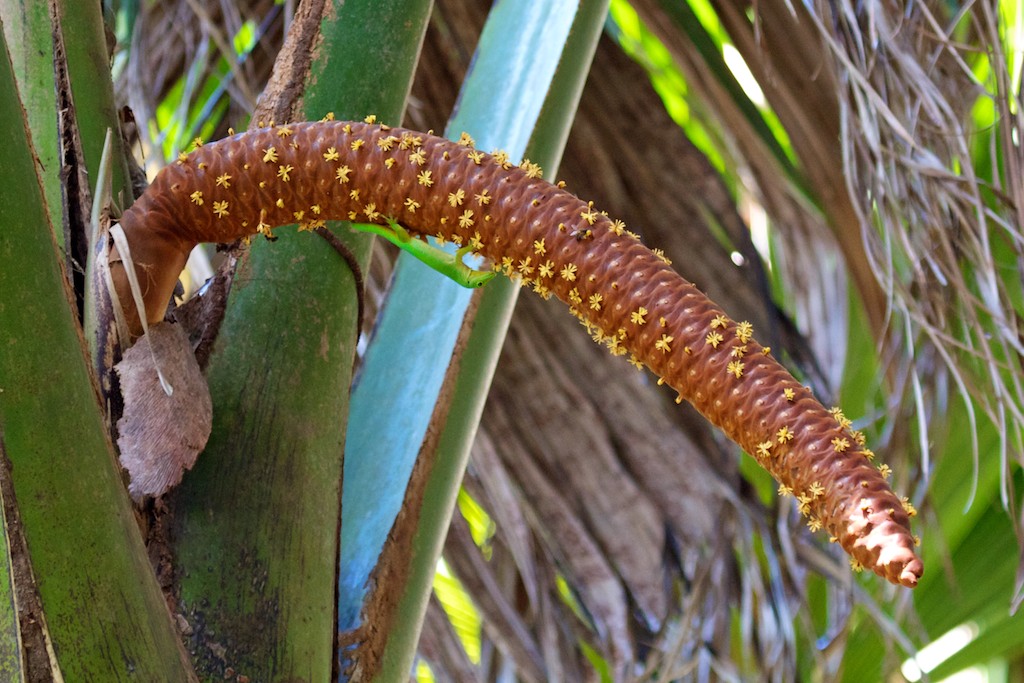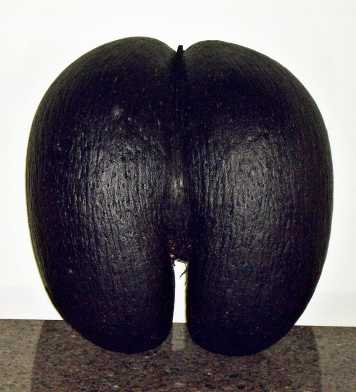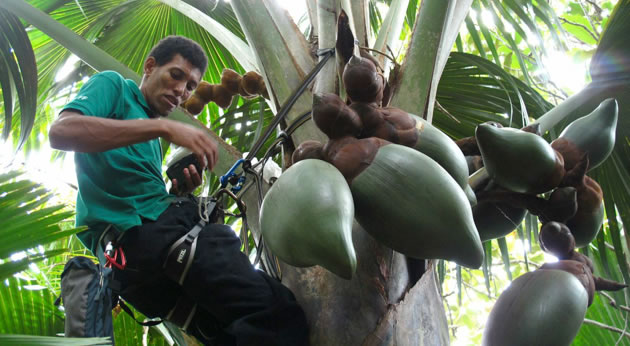Evolutionary dead-end as a success model
The coco-de-mer, or the double coconut palm of the Seychelles, grows the largest and heaviest seeds in the entire plant kingdom. Ecologists working with ETH Professor Peter Edwards explain how these plants are able to achieve this feat despite low nutrient levels.
The double coconut palm, also known as the coco-de-mer, is the stuff of legend – thanks largely to the odd shape of its seeds. The fruit of the double coconut palm, which houses the tree’s enormous seeds, is also quite unusual from a scientific perspective: it weighs up to 18 kg and can reach a diameter of half a metre.
To researchers, the size of the fruit is all the more remarkable because it is an evolutionary dead-end for the palm. The heavy seed hampers the plant’s dissemination significantly, as the ripe coconut falls to the ground and remains there. The double coconut palm also grows in soil that is extremely low in nutrients. The gigantic fruit therefore appear to be wasteful, an evolutionary contradiction, but researchers working with Peter Edwards, emeritus professor of plant ecology at ETH, have presented new observations.
Leaves like funnels with gutters
The palm has developed a clever mechanism to optimise the provision of nutrients for itself and its offspring – and as a result produces large seeds. It is the only plant species that takes care of its offspring in order to increase their chances of survival.
In order to care for its seedlings, the palm has evolved a perfect system of funnels and gutters that redirects nutrients and water to the benefit of its offspring, as well as the tree itself. The leaves function like a funnel, efficiently capturing rainwater, which the stalks then divert to the base of the palm tree.

Edwards, Christopher Kaiser-Bunbury from TU Darmstadt and Frauke Fleischer-Dogley from the Seychelles Islands Foundation demonstrate how the nutrient-rich residue of animal faeces, pollen and dead plant material that collects on the palm leaves is directed with the water to the base of the tree, thus fertilising the soil with phosphates and nitrates. A soil analysis conducted by the researchers confirmed that the concentration of phosphorous and nitrogen 20 cm away from the tree is 50% higher than at a distance of two metres.
Coco-de-mer also optimises the use of nutrients. The three researchers discovered that the leaves and trunk contain very little nitrogen and phosphorous. “Both nutrients are low in these plant parts because the palm tree has very few nutrients at its disposal from the surrounding environment, and it has also developed in such a way that all available resources are invested in its flowers, inflorescence and fruit,” says Kaiser-Bunbury.
Benefits of falling close to the tree
The double coconut palm’s efficient nutrient use and ingenious enrichment system explain how it can grow oversized seeds, but not the evolutionary meaning behind it. “We must therefore look further back in evolutionary history,” says Edwards, the lead author of a study recently published in New Phytologist.
Early forms of the double coconut palm, which can be traced back to African ancestors, probably depended on animals to disperse their seeds. When the Seychelles split away from India some 65 million years ago, the palm was isolated from the mainland and therefore from the animals that scattered its seed. From that point on, the seeds fell to the ground near the parent tree and stayed there. As a consequence, the seedling had to adjust to growing in the shadow of its parent’s canopy.
This adaptation and the nutrient supply, which grew over the course of evolution, gave the palm tree an advantage over other plants and it eventually displaced them. The double coconut palm thus became the dominant species, shaping the forest.
Competition among its own kind
The researchers interpret the size of the seed as a response by the palm tree to competition between seedlings of the same species. As a rule, most plant species form mobile seeds that can fly, swim or be transported by animals, so the seedlings do not compete with their parents for light, nutrients and water. The fruit of the coco-de-mer, however, is too big and heavy to be mobile. The young palm tree, therefore, is not only fighting with its parent for the scare resources but also with its “cousins”.
The larger the seed, the greater the nutrient supply available to a seedling for its growth. Fellow members of the species that possess lower reserves cannot prevail and thus eventually die off. “The competition for the transfer of their own genes within the species fuelled the race for even bigger seeds,” concludes Edwards.
This suggests that double coconut palm follows an evolutionary pattern found in other species that flourish on isolated islands: colonising plants on isolated islands develop large seeds over time. This is why island species have larger seeds than their mainland relatives.
Coco-de-mer

The double coconut palm or coco-de-mer (Lodoicea maldivica) is found only on the islands of Praslin and Curieuse in the Seychelles. It grows to between 15 and 20 metres high. Most trees are old, male specimens. It’s not until the leaves have access to the canopy, which means a trunk height of six to eight metres, that the double coconut palm begins to blossom and produce fruit. It requires up to seven years to grow and mature. Most palms produce no more than 10 coconuts at a time. The coco-de-mer is dioecious: the male and female flowers occur on separate plants. Researchers are still not sure how pollination occurs. Lizards that live in the palms may transport pollen to the female flowers. The double coconut palm is at risk, partly due to the trade in coconuts. As a result, stocks may be insufficient to regenerate.
Literature reference
Edwards PJ, Fleischer-Dogley F, Kaiser-Bunbury CN. The nutrient economy of Lodoicea maldivica, a monodominant palm producing the world's largest seed. New Phytologist, 23th January 2015, doi: external page10.1111/nph.13272call_made

